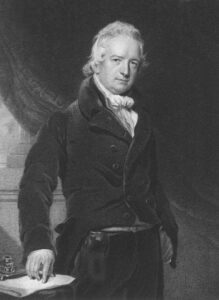 |
| John Abernethy, surgeon (1764-1831). Engraving by John Cochran after a painting by Thomas Lawrence. c. 1820-1840. First published in vol. 4 of Medical portrait gallery. Biographical memoirs of the most celebrated physicians, surgeons, etc., etc., who have contributed to the advancement of medical science. by Thomas Joseph Pettigrew. Via Wikimedia. Public Domain. |
John Abernethy was born in London in 1764 and went to school in Wolverhampton, where he learned Latin and Greek, and graduated top of his class. He would have preferred to study law but his father insisted he choose medicine. At age fifteen, he was apprenticed for five years to a surgeon with a large, lucrative practice who excited in him a passion for studying anatomy. He then followed the standard trajectory of becoming known and developing a surgical practice, working at first as a demonstrator in anatomy at the London Hospital. In 1787, he was elected assistant surgeon at St. Bartholomew’s Hospital and remained so for twenty-eight years until elected chief surgeon in 1815. By that time he had achieved considerable fame, having become a fellow of the Royal Society, and a lecturer at the Royal College of Surgeons.1-4
Early on he was influenced by John Hunter, whose views he espoused and whose work he continued. He carried out experimental work and published many articles on surgical diseases resembling syphilis and on the treatment of aneurysms, tumors, injuries, and abscesses. His connection with a large teaching hospital gave him the opportunity to teach, at first in his office outside the hospital. He became so popular a lecturer that when his audience overflowed his premises, the governors of St. Bartholomew’s hospital built a lecture hall for him, and thus he became the founder of St. Bartholomew’s medical school.
During his long academic career, he worked on many diverse subjects, including the dissection of a whale. He was a dogmatic lecturer, brooking no dissent and often putting down those who disagreed with him. He carried this brusque tendency over to his practice, saying that his private patients had the options of going elsewhere, unlike the “poor devils” at the hospital who had no choice. The best way to cure gout, he once told a luxury loving man indolent man, was to live on sixpence a day and have to earn it. A young woman complaining of abdominal discomfort was told she would be better off not compressing her thirty yards of bowel with her tight girdle. To a patient complaining there must be something wrong with his shoulder when he made a certain movement, he said he would be fool to do so. Yet on the whole he was kind and courteous to the patients on whom he was called in consultation. Once when he stubbed his toe against a paving stone, he asked an Irish workman to remove it but did not care where the hell he took it: the workmen replied that Heaven could be the best place because there it will be completely out of his way.1
It appears that he was a surgeon of competent but average capabilities. He continued John Hunter’s work on blood vessels and ligated the external iliac and also the common carotid arteries. He described a rare malformation of the portal vein that bears his name. He believed that most diseases were due to disordered states of the digestive organs, to be treated by purging, attention to diet, and a biscuit that he invented and popularized, the Abernethy biscuit. His lectures became classics, were plagiarized by being taken down verbatim, and were published in The Lancet. After his retirement he developed a lingering disease and died in 1831, remembered as the prototype of the early generation of surgeons who had successful private practices but also found time to advance the scientific basis of their profession.
References
- “John Abernethy.” Whonamedit? – A dictionary of medical eponyms
- “Abernethy, John (1764-1831).” Dictionary of National Biography. 1885-1900.
- King, L. “Saints and Sinners: John Abernethy.” The Royal College of Surgeons of England Bulletin. 2012.
- Macilwain, G. “Memoirs of John Abernethy.” Hatchard and Co, Piccadily. 1856.
GEORGE DUNEA, MD, Editor-in-Chief
Winter 2022 | Sections | Physicians of Note

Leave a Reply